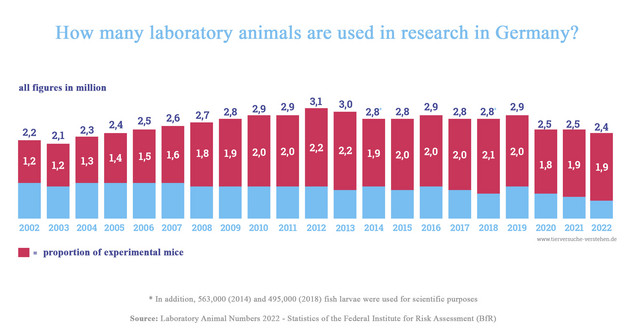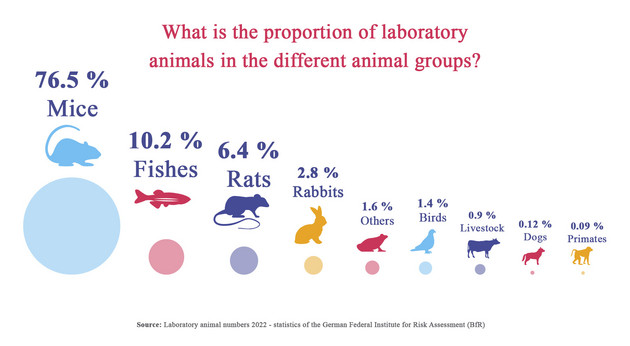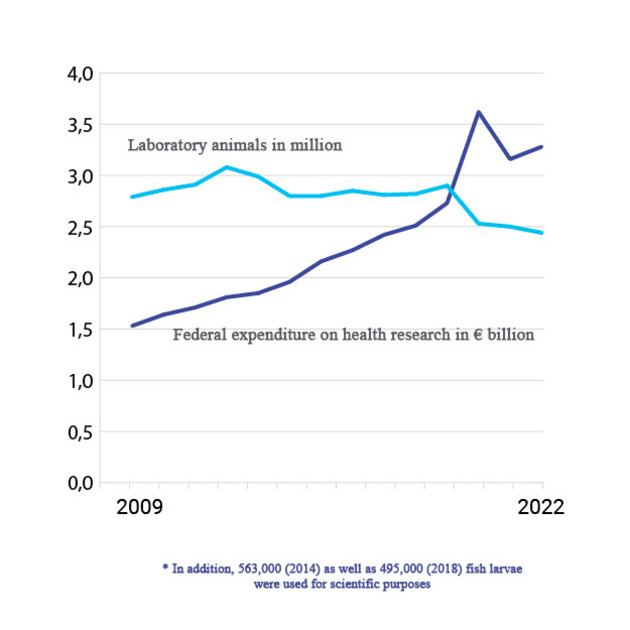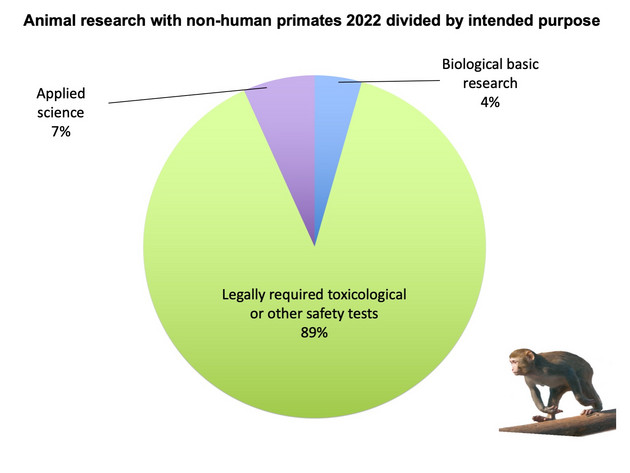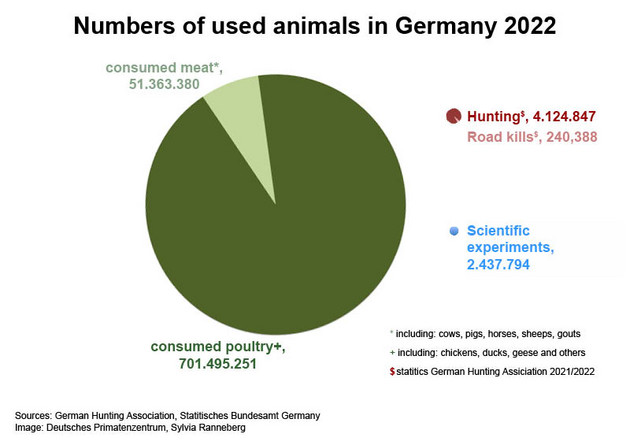An often misunderstood aspect in the public discussion on animal experiments in research, are the annual official numbers of experimental animals. In Germany, all experiments on vertebrates must be approved and the number of animals must be reported to the responsible state authorities. Until 2020, the authorities transmitted the figures to the Federal Ministry of Food and Agriculture (BMEL), which finally informed about the overall figures once a year. Since 2021, the competent authorities have reported the figures on the laboratory animals used to the German Federal Institute for Risk Assessment (BfR) in accordance with Section 1 (2) of the Laboratory Animal Reporting Ordinance. The most recent figures are from 2022 and were published on December 11, 2023. Starting in 2021, all laboratory animal statistics will be published by the German Center for the Protection of Laboratory Animals (Bf3R), which is part of the Federal Institute for Risk Assessment (BfR). The basis is the Experimental Animal Reporting Ordinance, which was amended in May 2021. Detailed information on the laboratory animal numbers 2022 can be found at BfR.
In recent years, media and animal research critics have generally confined themselves to pointing out the higher total number of animals. However, the ministry covers many different types of operations and only a glance at the details, makes it possible to fully understand the animal research totals for Germany. In addition, the comparison of experimental animal numbers with other areas of animal use in Germany (for example, food production) helps to understand the relationship between animal experiments and animal consumption. The following will help you find the answer to the questions:
- Why is there as often reported no permanent increase in the number of animal experiments?
- Why do nonhuman primates represent only one-thousandth of all experimental animals?
- How many nonhuman primates do researchers at the German Primate Center use for their research?
- How many animals are used in Germany in areas other than in research and what are these areas?
Animal figures - no permanent increase

In Germany all experiments with vertebrates must be approved and the number of animals must be reported to the relevant authorities. However, in Germany this figure is only a part of the annual numbers of experimental animals. For animal tests in the scientific sense, interventions are made to manufacture products, substances or organisms, for training purposes or the removal of tissues or organs for use in alternative methods.
Statistics for 2009 to 2022 shows that the numbers of test animals used in Germany are subject to only a slight fluctuation (Figure 1). Over the past nine years between 2,5 and 3 million animals have been used annually. In 2022, 2,437,794 animals were used for scientific purposes. Included in this count are 1,725,855 animals used in animal experiments and 711,939 animals that have been euthanized for scientific purposes without experimental intervention, i. e. used to obtain cells for cell culture, for example.
The statistics for 2022 also include data on animals that were bred and euthanized but not used for scientific purposes. This amounted to a further 1,769,437 animals. Breeding for animal experimentation inevitably results in animals that are not suitable for the animal experiments in question. For example, in breeding, not all animals express the desired genetic characteristics ("Mendel's rules"). Such biological laws cannot be overridden, and even with careful planning, animals will inevitably be born that do not carry all the desired traits as a result of breeding. Scientists consequently have to breed more animals than they ultimately need for the animal studies. Other, uncontrollable factors, such as litter size, also play a role.
Due to the adjustment of the German Animal Protection Law to the EU directive on the protection of animals used for scientific purposes, the counting method of animals has changed in 2014. Up to and including 2013, those animals were recorded at the start of an experiment and since 2014 the animals had to be reported upon completion of the experiment. As a result, some animals are counted twice or even three times during the transition time. The number of transgenic animals has also changed. Breeding animals are now partially counted. This reflects a higher number of animals, even though more animals were not used in the experiments. Another difference concerns the non-invasive investigations such as behavioral studies. In certain federal states these are now included in the total number of experiments.
Of all the counted experiments, also included those that are less stressful: For example, it must be reported if blood is taken from a rhesus macaque at the DPZ. The process is performed under anesthesia and the animal does not suffer permanent harm.
The proportion of all animal experiments attributed to basic research in 2022 was 956,933 (55 percent). Mice, rats and fish continue to be by far the most frequently used laboratory animals, accounting for 91 percent of the total. In 2022, a total of 2,204 monkeys and prosimians were reported in experiments, 17 percent more than in 2021 (1,886 animals in experiments). Primates are largely used for legally required safety testing of potential drugs and other substances. The proportion of rabbits (approx. 4 percent) has increased by less than 1 percent compared to 2021. The proportion of birds (domestic fowl and other bird species) remained almost the same at around 2 percent compared to the previous year. In the 2022 reporting year, 2,873 dogs were reported in experiments, 8 percent more than in 2021 (2,657 animals in experiments). In contrast, the number of cats in experiments fell significantly by around 38 percent compared to the previous year (2021: 862 animals in experiments). Looking at the last few years, however, it can be seen that the number of dogs and cats was below the average for the last five years (Figure 2).
The moderate decline in the number of laboratory animals used in biomedical research, which continues to grow, shows that biomedical research is becoming increasingly economical with laboratory animals. It contributes to a constantly growing field of research with a decreasing proportion of laboratory animals. For example, federal spending on health research alone has risen by an average of around 6 percent each year since 2010. The pandemic has once again led to a drastic increase in federal research spending on health research, following a steady rise in previous years. In 2020, for example, spending rose by 33 percent to around 3.6 billion euros compared with the previous year. In 2021, spending increased again to 3.74 billion euros. While the number of laboratory animals has fallen steadily in recent years, funding for biomedical research continues to increase significantly. Over the past ten years, the German government has increased spending on health research from 1.85 billion euros in 2013 to 3.28 billion euros - an increase of 77 percent. The number of laboratory animals, on the other hand, showed no growth. (Federal Report on Research and Innovation 2023).
One reason for this is the internationally recognized 3Rs principle for reducing experiments to a necessary minimum. This ethical principle is practised daily in science, which is also reflected in the stable number of laboratory animals as the scope of research increases (Figure 3).
Non-human primates - only a thousandth of experimental animals
Nonhuman primates represent less than one-thousandth of all research animals in Germany (in 2022 it was a total of 2,204). They are used only in experiments of greater scientific importance and only if there is neither an alternative method nor the possibility of carrying out the experiment with less developed species.
Nonhuman primates are also used to study serious diseases, to test medical product development, or to test the safety of drugs, ingredients or medical products.
The basic research accounts for only 4 percent of the total (98 animals, see Figure 4). 89 percent of these non-human primates used in Germany (1,957) are used because legislators prescribe it: they are used for toxicity tests or other safety assessment of products used by humans. Such tests are not part of the research at the German Primate Center.
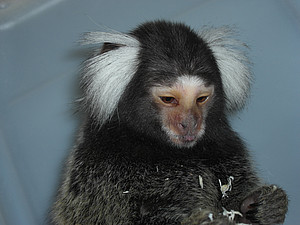
The numbers of non-human primates (both old world and new world) in basic biological research at the German Primate Center, varies from year to year. Generally, the figures in the past few years have been around 100 to 250 animals. Because of the different research projects from the institute's wide range of topics, this is a necessity. They were, for example, infection research projects (for example HIV vaccines) as well as from neurosciences (development of neuroprosthetics) and reproductive research.
Comparing experimental animal numbers with the number of animals used for other purposes
If the approximately 2.4 million scientific interventions on vertebrates are compared to the annual meat production in Germany, the animals killed in the hunt (see Figure 5), the figures are quickly brought into perspective.
Figures of experimental animals compared to other figures of animal usage
According to the Federal Office for Statistics (Destatis), more than 51 million pigs, cattle, sheep, etc. and over 700 million poultry were slaughtered in Germany in 2021. In the course of a lifetime, each German eats an average of 700 chickens but only two mice are used for biomedical research. On a purely statistical level, in the course of one’s life, a total of 0.0017 non-human primates would be used in experiments.
The number of nonhuman primates used for research purposes, is far less than the number of animals killed in everyday road traffic in Germany: the official number of accidents with wild boars or deers, collected by the German hunting association amounted in 2021/2022 to over 240,000 animals - the estimated dark figure is about five times as high. Not all accidents are reported and accidents involving animals such as rabbits, rodents and birds are not considered part of the statistic.
Sources for the numbers:


